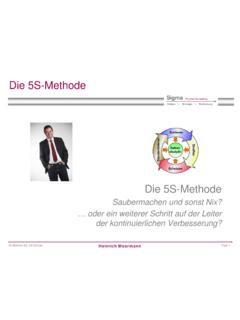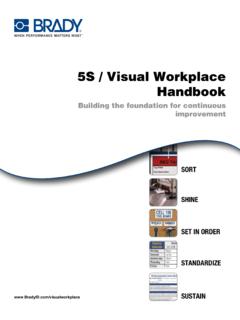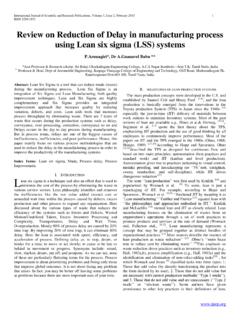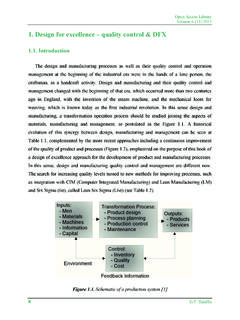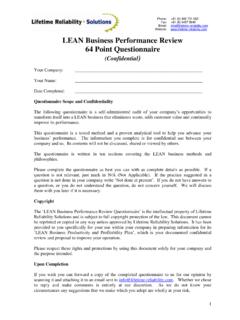Transcription of LEAN MANUFACTURING 5S AND SIX SIGMA Page …
1 lean MANUFACTURING , 5S AND SIX SIGMA . Page 1 of 8. PREPARED BY THE FOLK GROUP. THIS MAY BE REPRINTED WITH ATTRIBUTION. FEBRUARY, 2009. We're big fans of lean MANUFACTURING practices, 5S and Six SIGMA based on the results we've seen in metal casting plants as well as in other MANUFACTURING companies. If you are not embracing and implementing these concepts, chances are your company is not moving forward. If you are not continually improving you are moving backwards relative to your competitors. lean MANUFACTURING . lean MANUFACTURING is the implementation of the concept that anything that does not create value in the product is to be eliminated.
2 It is the concept of more value for less work. As trained industrial engineers, it seems pretty basic to us. Its simplicity is what makes it work. While the Japanese are rightfully given credit for re-vitalizing the concept of lean , its roots really go back to Frederick Winslow Taylor of Bethlehem Steel in the 1880s and 1890s. Then it was called Scientific Management.. The Taylor approach starts with a clean slate it designs the process to, as much as possible, only include steps that create value in the product. It is well suited for new plants, new products or new processes. The Japanese approach addresses existing plants, products and processes.
3 It is focused on eliminating waste (anything that is not adding value). As waste is reduced, quality improves, production times are reduced and cost is minimized. Various methodologies are used as tools to achieve this including Value Stream Mapping, 5S, Kanban (pull systems) and error-proofing. Our view is that starting with Taylor's approach lets you establish the perfect world as a base line. Using the Japanese approach then helps you work toward the perfect world. Let's use a casting example. A typical process might be to cast, clean, finish, re-clean, machine and ship. Why do we clean, finish and machine?
4 We know these processes often can't be eliminated but why not try? If the casting can be produced as-cast either by achieving best practice methods or changing casting methods (investment casting and lost foam often achieve as-cast parts), machining can be eliminated or minimized. If you don't put the stock on you don't have to take it off. Why is finishing (or at least why is so much) required? We know a state-of-the-art OEM producing iron castings in green sand that require almost no finishing. Are you grinding/trimming parting lines? Then your patterns or molds may need attention. Are you grinding rough casting surfaces?
5 Then your sand is not right or your die casting practices need improvement. Grinding gates? Can they be relocated to areas where they can be left untouched and minimized using knife gating? Are you welding? If you are not joining parts in welding all you are doing is fixing mistakes. Why do you clean before finishing? Good sand and shake-out practices should produce castings that are clean enough for finishing. Just clean one time after finishing. What's your scrap level? If you're not under 3% total scrap, no matter what casting method you use, you are not achieving best practice. That's without welding and other salvage operations by the way.
6 There are metal casters achieving these levels every day. How do they do it? They share a lot of common traits. First, they understand what best practice is for the process they are using. That includes melting, molding, sand preparation, finishing or what-ever process they are using. They know the best practice way to do everything. You would be surprised at how many metal casters we visit who don't know what can be done. Next, they are fanatic about doing it the right way. That 2009 The Folk Group, Doylestown, PA, 18901. lean MANUFACTURING , 5S AND SIX SIGMA . Page 2 of 8. means equipment is well maintained, systems are defined, documented and implemented the same way every time and everyone is well trained and does their job right.
7 After that they focus on problem jobs ones that require re-design, special gating, handling or other steps to insure they are scrap free. Finally, they document all scrap and attack issues. There are other lean practices to implement. If production flows perfectly, there is no inventory waiting to be worked on. Metal casters have helped minimize work-in-process by installing conveyor lines to keep castings moving right through to finished goods storage. This eliminated putting the castings in totes and the added handling. One low to medium volume gray/ductile iron jobbing foundry (casting weights under 50 pounds) we know now ships 30% of its production the same day and believes they can achieve 70% same day shipment.
8 These standards aren't just for the high volume or dedicated metal casting companies any more. Autonomation or smart automation is a part of lean MANUFACTURING as well. Autonomation refers to automating the process so humans can focus on what humans do best. The objective here is to design the machine so it knows when it is working abnormally and alerts a human. The human no longer has to monitor normal production but can focus on abnormal or fault conditions. Removing routine and repetitive activity reduces the chance for error. lean MANUFACTURING is focused on doing the right tasks, at the right place, at the right time, in the right quantity to achieve perfect work flow while eliminating waste (scrap) and with the ability and flexibility to change.
9 Implementing lean MANUFACTURING often requires a cultural change in all levels of the organization. Once management is committed, a program needs to be started that begins with small successes and grows to include the entire organization. The Toyota Production System (TPS) focuses on muri and muda. Muri focuses on the preparation and planning of the process, or what work can be eliminated in the design process. Muda are those waste steps and processes that add cost. Muri is used in new product design and muda is used to improve existing operations. TPS identifies 7 key muda*. They are: Transportation (moving products that is not actually required to perform the processing).
10 Inventory (all components, work-in-process and finished stock not being processed). Motion (people or equipment moving or walking more than is required to perform the processing). Waiting (waiting for the next production step). Overproduction (production ahead of demand). Over Processing (due to poor tool or product design creating activity). Defects (the effort involved in inspecting for and fixing/scrapping defects). *From lean Thinking , Womack, James P. and Jones, Daniel T., Free Press, 2003, p. 352. 2009 The Folk Group, Doylestown, PA, 18901. lean MANUFACTURING , 5S AND SIX SIGMA . Page 3 of 8.
